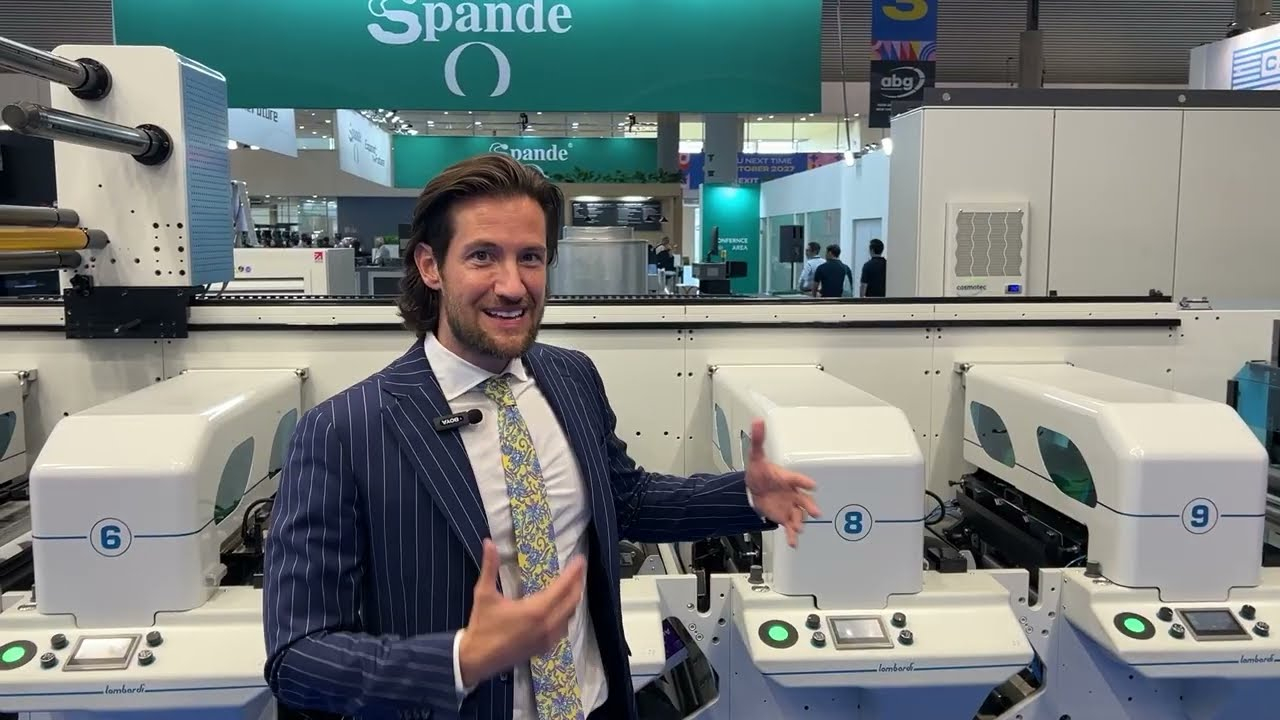How strong is the digital challenge?

Digital and conventional press developments at Labelexpo Americas 2011 pose some interesting questions about market directions. Report by Barry Hunt
The optimism shown at Labelexpo Americas 2010 was a welcome respite for some conventional press makers. Like others, they had seen steep falls in sales over a lengthy period of global downturn, although several have continued to develop new models or upgrade existing ones. One of the more interesting issues, however, revolves around the likely impact of digital label printing on key aspects of press makers' businesses. As reference points, both of the two last Labelexpo events comprehensively showed just how far-reaching digital printing technology has become as a mainstream process.
The sector's two big hitters, HP Indigo and Xeikon, have each brought highly individual approaches to digital printing over many years with considerable effect. The emergence of industrial inkjet printing in the label sector adds an extra dimension to the fast-growing market for short-run, print-on-demand applications. In all cases, the various print-on-demand technologies have begun to benefit from efforts to more closely integrate prepress systems, MIS and in-line/off-line finishing into effective workflows.
From the sidelines we can readily accept that digital printing complements conventional printing methods. Most installations are, after all, in mixed process plants. There is also much evidence that the best of digital printing for premium labels equals that produced on most UV flexo presses. Less clear is whether the process can seriously challenge the low-to-mid end of the flexo press market as many claim. They cite improved imaging techniques, wider substrate ranges and specialized ink systems to support their argument. The arrival of models that additionally convert unsupported packaging films add to digital's appeal. Digital's trump card is that some high-end developments have pushed print run thresholds further into flexo territory. The breakeven point where digital jobs cost less per copy depends on the type of job and set-up costs, but up to this breakeven point it is argued that digital printing costs far less for short runs.
Interestingly, Labelexpo Americas was the first event where such claims, or 'perceptions' were challenged to any great degree. Typifying this move was Mark Andy. Under the banner ‘It’s Not About Digital – It’s About Performance’ it demonstrated fast set-ups of four-color jobs on the new P5 and established P7 UV flexo platform presses as part of its Performance Series. A basic entry-level P3 version was launched in December. The subtext to its message was that label printers should not compare digital printing with the older types of in-line flexo workflows, rather they should look to the newer workflow methods.
As part of this movement, designers place more emphasis on shortening web paths and adding automated controls to reduce start-up times and waste. Examples included Omet's X-Flex 430 gearless combination press. (An exceptionally short web path is useful when demonstrating a press configured with twelve UV flexo units, plus two interchangeable rotary screen cassettes and rail-mounted cold and hot foiling units.) In another US debut, the ECS 340 from Gallus presented another take on handling short-to-medium runs. A granite mainframe core, with an integrated water cooling system, gives the press a long service life, reduced noise and greater stability. The approach taken by Dutch press maker, MPS Systems, revolves around its Automatic Print Control system, backed by short web paths and full lateral and running register control. APC has allowed it to replace all manual controls on its EC and EF series of servo-driven UV flexo presses.
The wider scene
The introduction of wider UV flexo presses for mixed label/packaging production is an interesting development. MPS demonstrated the 16 in wide EC 410 press for packaging and labels, but it also offers the new 22 in wide EXL packaging press with inline lamination, UV curing, and hot air dryers for water-based and solvent inks. Nilpeter introduced the new 22 inch wide FA-6. It heads up the established FA-Line series and uses lightweight sleeve/plate technology with servo-driven automated controls. Similarly equipped for high-volume film packaging and label printing is the new 16.5 in wide FG-4200.
Manufacturers of the mid-web offset-based combination presses, or derivatives of web-offset presses, also target this market. Among some interesting commercial developments, Sanden in Ontario and Marathon near Montreal have formed a strategic alliance to serve the commercial, forms, direct mail, label, and packaging markets in Canada, the US, and Mexico. Sanden-Marathon also became sole distributor for Edelmann Graphics' new STAR-Print (Sleeve Technology Advanced Rotation) press for the North American packaging and label markets. A cassette-based system allows an 'open platform' allowing mixed process production. As many will remember, the former RDP Marathon company was acquired by Drent-Goebel in 2005, a few years before the Dutch-based company went out of business. Muller Martini acquired the patents for DG's pioneering and proven VSOP sleeve system to develop for its Alpina mid-web offset presses.
Digital growth
To return to the general digital scene, over 1,300 digital label presses are said to be installed worldwide. This represents around 13 percent of all new label presses installed. With 250 new digital presses installed annually, pundits expect an installed base of around 25-30 percent by 2017. Consequently, there are good attendances for digital seminars, hands-on training sessions and technical workshops, either organized by independent companies or through vendors' in-house training facilities.
For the first time, a series of Digital Technology Workshops gave attendees some idea of the comparative set-up and run-time performances required for both conventional and digital technologies. The processes shown were High Definition Flexo (HD) centered on a Nilpeter FB-3300S press, electrophotographic liquid toner with HP Indigo's seven-color WS6000, dry toner with a Xeikon 3030 press and UV inkjet printing on a EFI Jetrion's newly-developed 4830. Tailored Solutions, CERM and EFI/Radius demonstrated their various approaches to MIS workflows as part of the individual label projects. The feedback among attendees has prompted a reprise at Labelexpo Europe 2011. Possible features include the comparative opacity levels of Whites, the role of digital pre-press with automated JDF-enabled workflows and MIS tools, and the HD Flexo process.
HP Indigo now claims to be among the top three leading press makers (conventional and digital). The changing print-run thresholds mentioned earlier mean that its flagship WS6000 is capable of handling roughly 80 percent of all label jobs. The same model will also print shrink sleeves and small cartons in web widths up to 13 in. Xeikon's revamped 3000 Series includes the new high-end 3500 model and the entry-level Xeikon 3050, both with imaging widths up to 20 in on paper or filmic substrates. They are said to take the digital/analog breakeven point to over 14,000 linear feet. Both models ran with an automated EskoArtwork JDF-enabled workflow system and CERM management information system. The Xeikon 3030 is an upgraded entry-level press for 13 in wide webs which replaces the 3000 model.
UV-cured CMYK inkjet printing is riding high on the back of developments involving piezoelectric printheads. Single-pass presses range from sophisticated stand-alone models down to basic reel-fed platforms. Show developments included EFI Jetrion's turnkey packages for labels and packaging based on its newly-acquired Radius MIS business. It demonstrated Jetrion 4000 and 4830 models with Xaar's 1001 printheads driven by EFI’s Fiery XF front-end for printing CMYK with optional white to a web width of 8.3 in. Both can re-register webs of die cut and/or part-printed labels, which could appeal to certain brand owners seeking some element of in-house label production.
Low-heat LED curing using compatible inks offers an interesting alternative UV curing. Coupled with LED pin fusing to give optimum color matching, this technology is now available on EFI Jetrion's new 4830LED. Users can print heat-sensitive materials, including shrink sleeve films, without pre-coating or pattern-coating. It retains the same grayscale printheads with variable sizes of ink drops to achieve speeds up to 120 ft/min.
LED curing is also standard on the ITS600, a fast UV inkjet label press from CSAT GmbH. It runs CMYK or four spot colors at up to 150 ft/min using Kyocera piezo printheads with a four-level grayscale delivering 600 x 600dpi. As with the pioneering Jetrion 4000 series, users can re-register webs of die cut labels. Other stand-alone models included Domino's new N-Series, with in-line finishing modules and featuring scalable print-width. The 13 in wide N600 label press uses an EskoArtwork digital front-end and operates in-line with a digital finishing line using a dancer roller web infeed. It uses Kyocera KJ4 piezo printheads to print up to 164 ft/min, or 246 ft/min with three grayscales printing onto a range of paper and plastic label stocks. A White ink for filmic labels is in the pipeline.
The latest Tau 150-8C from Durst prints CMYK and White with Orange and Violet to cover 90 percent of the Pantone range. It prints webs up to 6.5 in at 157 ft/min using four Xaar 1001 grayscale printheads for each color. An additional varnish module is available. Durst Canada's DIVA gives various single-pass varnishing effects as part of the off-line Rotoworx 330 finishing line. Epson’s six-color SurePress L-4030 differs in using water-based pigmented inks and two-stage hot air dryers as part of a stop/go scanning process across a 13-inch wide web. The ink set offers CMYK, Green and Orange, but not White at present. Epson MicroPiezo printheads print at 720 x 720dpi on paper and 1,440 x 720 dpi using film.
In summary, the inkjet sector has added a further, if not highly fragmented, dimension to the digital scene. Pundits expect the technology will produce a wider variety of substrate widths, as well as inks/fluids, with faster print speeds. The development of LED curing appears to be an ideal match for inkjet printing on most substrates. While the market opportunities seem bright, it will be interesting to see how an overcrowded market will resolve itself during future Labelexpo events.
This article was published in the 2011 L&L Yearbook
Stay up to date
Subscribe to the free Label News newsletter and receive the latest content every week. We'll never share your email address.


